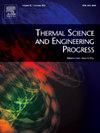Comprehensive experimental investigation on the performance of a direct spray tower for water evaporation
IF 5.1
3区 工程技术
Q2 ENERGY & FUELS
引用次数: 0
Abstract
Evaporative cooling is a widely applied cooling and humidification method. This study designed and constructed a direct spray tower based on pressure swirl nozzles, which generate sprays with a particle size range of 36 – 44 μm to enhance water evaporation. The experimental parameters included water flow rate, inlet air temperature, inlet air humidity and air velocity. The effect of the operating conditions on spray tower performance parameters, including outlet air temperature, humidity, humidification capacity, humidification efficiency, saturation efficiency and energy efficiency ratios was comprehensively investigated experimentally. The results show that the humidification efficiency depends on both the spray pattern and the water flow rate, reaching a maximum value of 55 %. Reducing inlet humidity from 47 % to 12 % enhances humidification capacity by 53.2 %. Cooling energy efficiency ratio and humidification energy efficiency ratio increase in inlet air temperature and decrease in air velocity and inlet air humidity. Finally, Correlation equations proposed based on experimental data predict outlet temperature and saturation efficiency within ±10 % and ±15 % errors for 98.9 % and 96.7 % of data, respectively. It provides a reference for the design of spray towers.
水蒸发直接喷雾塔性能综合试验研究
蒸发冷却是一种应用广泛的冷却加湿方法。本研究设计并构建了基于压力旋流喷嘴的直接喷雾塔,产生粒径范围为36 ~ 44 μm的喷雾,以促进水分蒸发。实验参数包括水流速率、入口空气温度、入口空气湿度和空气速度。实验研究了不同工况对喷淋塔出水温度、湿度、加湿量、加湿效率、饱和效率和能效比等性能参数的影响。结果表明,加湿效率既取决于喷雾方式,也取决于水流速度,最大可达55%。将进口湿度从47%降低到12%,可使加湿能力提高53.2%。冷却能效比和加湿能效比随进风温度的升高而升高,随进风速度和进风湿度的降低而降低。最后,根据实验数据建立了相关方程,预测出口温度和饱和效率的误差分别为98.9%和96.7%,误差分别为±10%和±15%。为喷雾塔的设计提供参考。
本文章由计算机程序翻译,如有差异,请以英文原文为准。
求助全文
约1分钟内获得全文
求助全文
来源期刊

Thermal Science and Engineering Progress
Chemical Engineering-Fluid Flow and Transfer Processes
CiteScore
7.20
自引率
10.40%
发文量
327
审稿时长
41 days
期刊介绍:
Thermal Science and Engineering Progress (TSEP) publishes original, high-quality research articles that span activities ranging from fundamental scientific research and discussion of the more controversial thermodynamic theories, to developments in thermal engineering that are in many instances examples of the way scientists and engineers are addressing the challenges facing a growing population – smart cities and global warming – maximising thermodynamic efficiencies and minimising all heat losses. It is intended that these will be of current relevance and interest to industry, academia and other practitioners. It is evident that many specialised journals in thermal and, to some extent, in fluid disciplines tend to focus on topics that can be classified as fundamental in nature, or are ‘applied’ and near-market. Thermal Science and Engineering Progress will bridge the gap between these two areas, allowing authors to make an easy choice, should they or a journal editor feel that their papers are ‘out of scope’ when considering other journals. The range of topics covered by Thermal Science and Engineering Progress addresses the rapid rate of development being made in thermal transfer processes as they affect traditional fields, and important growth in the topical research areas of aerospace, thermal biological and medical systems, electronics and nano-technologies, renewable energy systems, food production (including agriculture), and the need to minimise man-made thermal impacts on climate change. Review articles on appropriate topics for TSEP are encouraged, although until TSEP is fully established, these will be limited in number. Before submitting such articles, please contact one of the Editors, or a member of the Editorial Advisory Board with an outline of your proposal and your expertise in the area of your review.
 求助内容:
求助内容: 应助结果提醒方式:
应助结果提醒方式:


